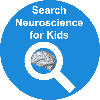 | Sign Language and the Brain |  |
 | Sign Language and the Brain |  |
|
By Melissa Lee Phillips Neuroscience for Kids Consultant April 17, 2002
Spoken language tends to be processed mainly by the left cerebral hemisphere. When ASL is used, structures in both the left and right hemispheres are activated. Moreover, spoken language appears to have a critical period when exposure to language is essential for its proper development. When someone is not exposed to language as a child, it is likely that this person will never fully develop language abilities. Also, if this critical period for language is missed, the left side of the brain will not be devoted to language, as it is in most people. In other words, if structures in the left side of the brain are not recruited for spoken language processing by a certain age, they never will be. According to a study from Aaron J. Newman and his colleagues at the University of Oregon, there may be a similar critical period involved with processing of ASL in the right hemisphere. This research shows that the right angular gyrus is highly activated during ASL processing in people who learned the language from birth, but not in those people who learned it after puberty.
This study is further evidence for the importance of the right hemisphere in understanding signed languages. It is also the first demonstration of a critical period for language processing in the right hemisphere. It seems that for both spoken and signed languages, the age at which the language is learned affects how the brain will be organized. Certain brain structures are normally used in language processing, but if the language is acquired after a certain age, these structures can no longer be recruited for this purpose. These results are important for our understanding of how human language is processed and for how the brain develops and changes. |
|
Reference:
|
| GO TO: | Neuroscience In The News | Explore the Nervous System | Table of Contents |
![[email]](./gif/menue.gif) Send E-mail |
 Get Newsletter |
 Search Pages |